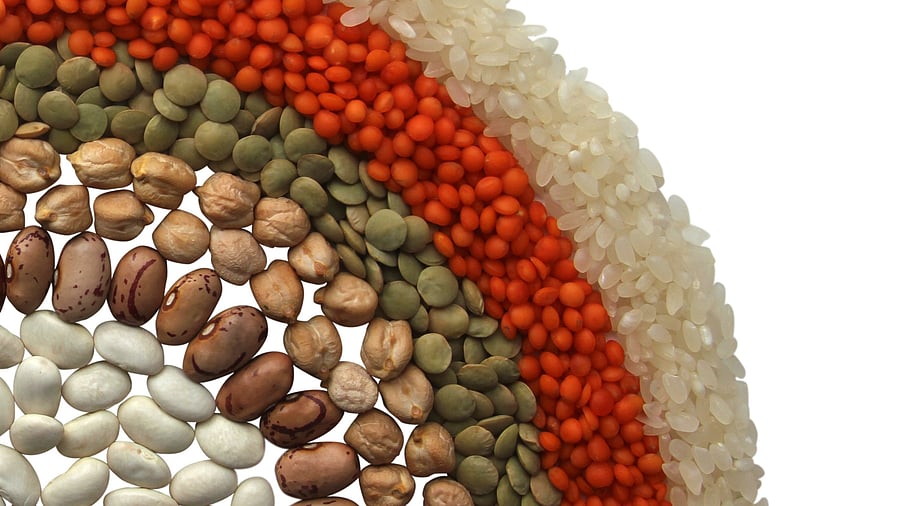
iStock Photo.
From barley, wheat and lentils in the Fertile Crescent, to rice in China, beans in the Andes, sorghum in Africa to maize in Central America, they’ve been a treasure for generations of people across different geographies, providing sustenance,
medicinal and personal care uses, and even currency value (when seeds were carried long distances for trade). In fact, the word ‘carat,’ a metric used for precious metals and gemstones, is said to be a derivative of ‘carob,’ given that the weight of the carob seeds in a pod are surprisingly homogeneous, which made them a clean choice to measure the weight of gold and diamonds.
Take, for instance, the seeds of the Mongongo or Manketti tree in the Kalahari desert, still an integral part of the diet of the bushmen — the San communities. In the Indian pantry, seeds take centre stage, gliding from seasoning pans to full-bodied gravies, breakfast bowls to supper staples. Most of us grew up witnessing the magic of seeds all around us, in our gardens and kitchens, as opposed to standing enthralled by a supermarket aisle filled with bottles of seeds of
all kinds, with labels that expound their nutritional value and health benefits. Seeds have also played a crucial role in the diets of hunter-gatherers and tribals.
Today, certain varieties of seeds are suddenly in the limelight, because they’re tagged as superfoods. Chia, flax, makhana and sunflower seeds occupy the top rungs of the power food ladder, but there are so many indigenous seeds that don’t get a deserving spot on the ladder at all.
During my childhood, I remember my grandmother culling out the seeds of all varieties of squashes, cucumbers, pumpkins, melons and drying them out in the sun, with some of the pulpy flesh still clinging on to their skins. They would then be roasted and stored in containers to add to various dishes. Jackfruit seeds were stored this way too, after a round of sun-drying, to be roasted and eaten as a snack, or steamed and cooked into a gravy dish. Pomegranate seeds were powdered to add a zing to certain foods, fennel, cumin and carom seeds were brewed as a tea for stomach disorders, poppy seeds were added to desserts, mustard seeds turned into a paste for condiments, and sabja (basil) seeds were soaked in water during the summers, offering respite from the heat. Puffed grains and cereals, roasted nuts and boiled or sprouted legumes have been the mainstay in most of our diets, performing different functions along the way — some offering the promise of proteins and other nutrients, or carbs, in snack form or as a filler between meals, or even being the hero of a meal.
Here are a few easy ways to use some indigenous varieties of seeds as new-again powerhouses of nutrition and healing, without heeding to the noise around some of the exotic ones, which are likely to cost an arm and a leg.
Overnight sabja & poha parfait
(Makes one serving)
2-3 tablespoons red rice poha, washed
1 teaspoon sabja seeds
4-5 tablespoons thick curd
A pinch of salt
1 tablespoon honey or jaggery powder. Mix everything in a bowl, and leave overnight in the refrigerator.
For the topping:
2 tablespoons pomegranate arils
1 elakki banana
A few slices of apples, melon or any other fruit of your choice
1 teaspoon of raisins
1 teaspoon of crushed, roasted nuts
1 teaspoon of roasted melon or pumpkin seeds
Top the parfait with the above, and serve immediately.
A healing superseed kashaya
(Makes one serving)
Ingredients
1 teaspoon each of coriander seeds, barley, red rice, cucumber seeds, fennel, cumin, ajwain.
Method
Gently roast all of the above on low heat, until the seeds turn a light brown and fragrant.
Cool and grind coarsely.
Brew like a tea, using 1 1/2 cups of water, with a pinch of dry ginger powder.
Add jaggery powder or palm sugar crystals according to preference.
Sip while hot for a soothing relief from heartburn, bloating or simply to enhance gut health .
(Note: You can dry the sludge after you make the tea, mix it with some castor oil, and use it as a salve to soothe stomach aches.)
Superseed sandwich spread
2 tablespoons each of — pumpkin seeds, melon seeds, white sesame seeds, flax seeds, poppy seeds, 10-12 almonds, 1/2 teaspoon cinnamon powder.
Roast all the seeds and the almonds on low heat.
Grind to a slightly coarse paste along with cinnamon powder.
At first the mixture will be gravelly and as you keep blending it in the mixie in short bursts, the oils will release and turn it into a thick paste.
Spread this on hot buttered toast, top with sliced bananas, a drizzle of honey and enjoy.
Crunchy fruit, nut & seed salad
2 cups mixed fruit, diced (apple, musk melon, pineapple, grapes, pomegranate, mango)
Juice of 1 big lemon
1 teaspoon cumin powder
Salt and pepper to taste
A sprinkling of jaggery powder
A pinch of black salt
1 tablespoon mint leaves, minced finely
2 tablespoons roasted nuts (cashew, almond, walnut)
3 tablespoons roasted seeds (sesame, pumpkin, cucumber, watercress, watermelon)
Method
Mix all the fruits, lemon juice and spices in a bowl.
Top with roasted nuts, and seeds, and serve immediately.
This makes a great mid-morning or evening snack.
(Ranjini Rao is a communications professor, author, and podcaster, straddling multiple worlds in Bengaluru. She’s passionate about urban farming and sustainable living, and can mostly be found cooking and baking in her little kitchen where, surrounded by heirloom coffee kettles and mismatched tea cups, she finds her chi.)